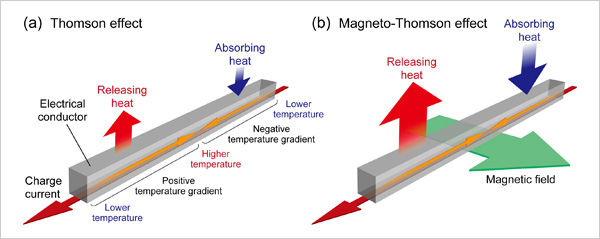World’s First Direct Observation of the Magneto-Thomson Effect
—Thermal Imaging Technique May Facilitate the Development of New Science and Technology on Heat, Electricity, and Magnetism Conversion Phenomena—
2020.09.02
National Institute for Materials Science(NIMS)
National Institute of Advanced Industrial Science and Technology (AIST)
NIMS and AIST succeeded for the first time in the world in directly observing the magneto-Thomson effect—the magnetic-field-induced modulation of the Thomson effect.
Abstract
- NIMS and AIST succeeded for the first time in the world in directly observing the magneto-Thomson effect—the magnetic-field-induced modulation of the Thomson effect (i.e., the heat release and absorption by applying a temperature gradient and a charge current to an electrical conductor). This success may contribute to the development of new functions and technologies for thermal energy management and to advances in fundamental physics and materials science on magneto-thermoelectric conversion.
- The Seebeck effect and the Peltier effect have been extensively investigated for their application to thermoelectric conversion technologies. Along with these effects, the Thomson effect has long been known as a fundamental thermoelectric effect in metals and semiconductors. Although the influence of magnetic fields and magnetism on the Seebeck and Peltier effects has been well understood as a result of many years of research, the influence on the Thomson effect has not been clarified because it is difficult to measure and evaluate.
- This NIMS-led research team observed heat release and absorption induced in an electrical conductor by simultaneously creating a temperature gradient across it, passing a charge current through the gradient, and applying a magnetic field. The team precisely measured temperature changes in the conductor associated with the heat release and absorption using a heat detection technique called lock-in thermography. As a result, the amount of heat released and absorbed was found to be proportional to both the magnitude of the temperature gradient and charge current. In addition, the team observed strong enhancement of the resultant temperature change when a magnetic field was applied to the conductor. The systematic measurements performed in this study demonstrated that the heat release and absorption signals detected under a magnetic field were indeed generated by the magneto-Thomson effect. This effect observed in the bismuth-antimony alloy used in this experiment exhibited very high thermoelectric conversion performance, which can reach the level of thermoelectric conversion performance of the Seebeck and Peltier effects.
- This research revealed the fundamental nature of the magneto-Thomson effect and established techniques to measure and evaluate the effect. We will continue the physics and materials science studies on the magneto-Thomson effect and create new thermoelectric conversion functions based on this effect. Specifically, we plan to apply it to the development of thermal management technologies that can be used to increase the efficiency of electronic devices. We also hope to observe new physical phenomena involving interacting heat, electricity, and magnetism.
- This project was carried out by Ken-ichi Uchida (Group Leader of the Spin Caloritronics Group (SCG), Research Center for Magnetic and Spintronic Materials (CMSM), NIMS), Ryo Iguchi (Senior Researcher, SCG, CMSM, NIMS), Asuka Miura (JSPS Fellow, SCG, CMSM, NIMS) and Masayuki Murata (Senior Researcher, Thermoelectric Materials Physics Group, Research Institute for Energy Conservation, AIST).
This project was mainly supported by the JSPS Grant-in-Aid for Scientific Research (B) (project number: 19H02585), the JST Strategic Basic Research Program CREST (project number: JPMJCR17I1) and the NEDO Feasibility Study Program under the Uncharted Territory Challenge 2050 category (project number: P14004).
This research was published in the online version of Physical Review Letters, a journal of the American Physical Society, as an Editors’ Suggestion article at 10:00 am on September 2, 2020, EST (11:00 pm on September 2, Japan Standard Time).

Figure 1. Schematic illustration of the Thomson effect and the magneto-Thomson effect
Related files
- Research Center for Magnetic and Spintronic Materials
Contact information
(Regarding this research)
-
Ken-ichi Uchida
Group Leader
Spin Caloritronics Group
Research Center for Magnetic and Spintronic Materials
National Institute for Materials Science
Tel: +81-29-859-2062
E-Mail: UCHIDA.Kenichi=nims.go.jp
(Please change "=" to "@") -
Masayuki Murata
Senior Researcher, Thermoelectric Materials Physics Group
Research Institute for Energy Conservation
National Institute of Advanced Industrial Science and Technology
Tel: +81-29-861-2864
Fax: +81-29-861-5340
E-Mail: m.murata=aist.go.jp
(Please change "=" to "@")
(General information)
-
Public Relations Office
National Institute for Materials Science
Tel: +81-29-859-2026
Fax: +81-29-859-2017
E-Mail: pressrelease=ml.nims.go.jp
(Please change "=" to "@") -
Media Relations Office
Public Relations Department
National Institute of Advanced Industrial Science and Technology
Tel: +81-29-862-6216
Fax: +81-29-862-6212
E-Mail: hodo-ml=aist.go.jp
(Please change "=" to "@")
Same Keywords
-
Development of a Novel Thermoelectric Material with Conversion Efficiency as High as Bi2Te3
(Thermal,AIST)
2021.04.17
-
MTJ Device with the World’s Highest TMR Performance Developed through Precision Interfacial Control
(magnetic)
2023.04.13
-
Cupric Oxide Exhibiting Both Magnetic and Dielectric Properties at Room Temperature
(magnetic)
2022.11.17
Recent Press Release
-
Simultaneous Imaging of Intracellular DNA and RNA Using Harmless Light
2025.10.27
-
Development of an AI Device Using Ion Gel and Graphene That Dramatically Streamlines Machine Learning Computations
2025.10.14
-
Demonstrating a Novel Method to Modulate Heat Flow Through the Collective Motion of Spins
2025.10.06
